Discover the captivating world of grey birds in North America with BirdSology. Despite their understated beauty, these birds possess a unique allure that is worth exploring. From their muted plumage to their diverse habitats and behaviors, there is much to uncover about these subtle feathered creatures. Join us on a journey as we delve into their fascinating characteristics and habitats, and gain a deeper appreciation for the charm that grey birds bring to our natural world. Get ready to be intrigued and inspired by these remarkable avian wonders.
List of 23 Grey Birds in North America
Gray Catbird
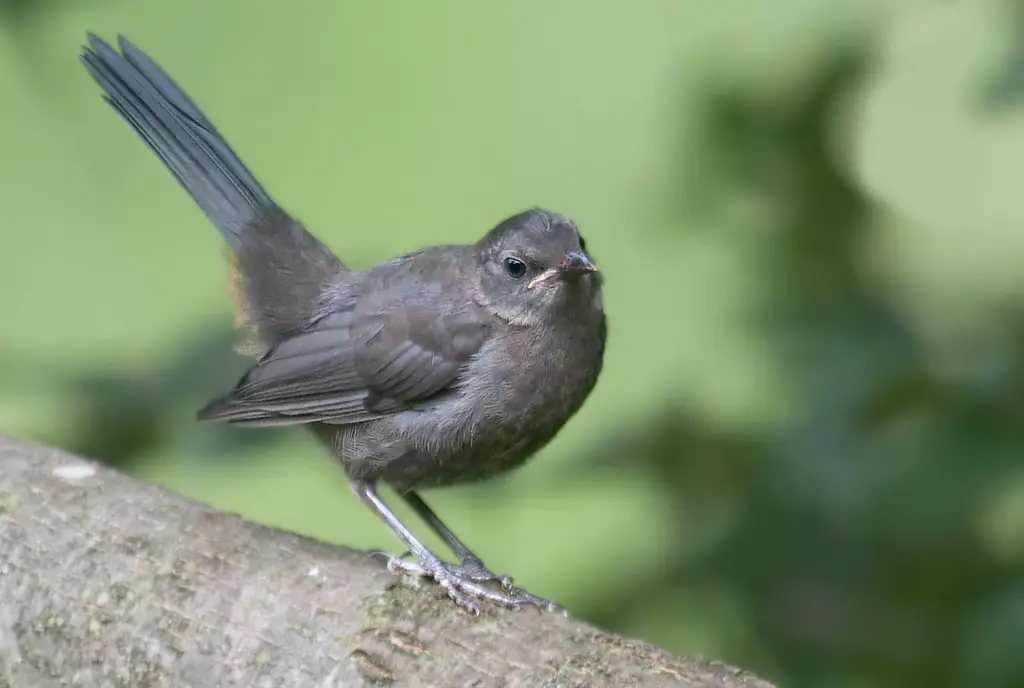
Image Source
- Scientific name: Dumetella carolinensis
- Lifespan: Up to 10 years
- Size: Approximately 22-24 centimeters (8.7-9.4 inches)
- Origin: North America (found in regions such as Canada, United States, and Mexico)
The Gray Catbird is a medium-sized songbird found in North America. It is known for its distinct gray plumage, the black cap on its head, and its ability to mimic the calls of other birds. Here is a short description of the Gray Catbird’s behavior and habitat:
Behavior:
Gray Catbirds are highly vocal birds and are known for their melodic songs, which often include a mix of original notes and imitations of other bird species. They have a wide range of calls and can mimic the songs of over 50 different bird species. Their vocalizations serve various purposes, including territorial defense and attracting mates.
In terms of feeding, Gray Catbirds are omnivorous. They primarily eat insects, berries, fruits, and seeds and are adept at foraging on the ground, in shrubs, and even in trees, using their bill to probe for food items. They are known to flick their wings and tail when agitated or excited.
Habitat:
Gray Catbirds are commonly found in thickets, shrubby areas, and woodland edges across North America. They prefer habitats with dense vegetation, such as tangled undergrowth and shrubs, which provide ample cover for nesting and foraging. They can also be found in gardens, parks, and suburban areas with suitable vegetation.
During the breeding season, Gray Catbirds construct cup-shaped nests made of twigs, leaves, and grasses, usually hidden within dense shrubs or vines. They lay a clutch of 3-5 eggs, which are incubated by the female for about two weeks. Both parents participate in raising the chicks until they fledge and become independent.
Black-capped Chickadee (Small Grey Birds)
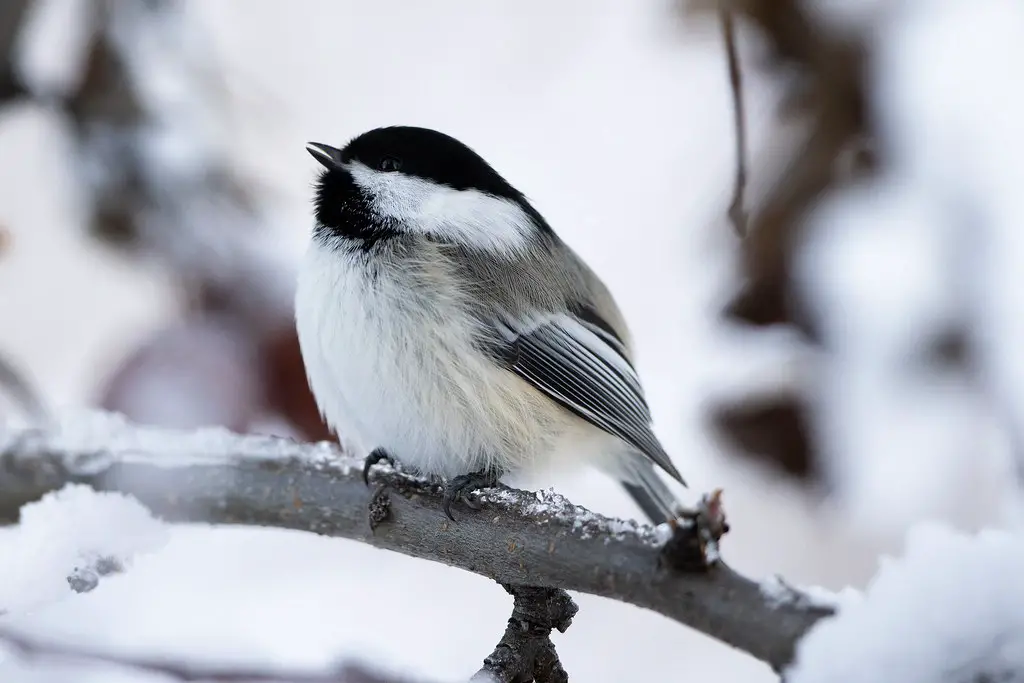
Image Source
- Scientific name: Poecile atricapillus
- Lifespan: 2-12 years
- Size: 12-15 centimeters (5-6 inches)
- Origin: North America
Black-capped Chickadee is a small, charismatic bird native to North America. With its distinctive black cap and bib, white cheeks, and grayish wings, this energetic chickadee is a common sight in forests, woodlands, and suburban areas.
Black-capped Chickadees are known for their cheerful songs and calls, including their signature “chick-a-dee-dee-dee” call. They are agile foragers, flitting from branch to branch, searching for insects, seeds, and berries. These birds have a remarkable ability to store food and can remember thousands of hiding places.
During the breeding season, Black-capped Chickadees excavate cavities in trees or use nest boxes. The female lays a clutch of 5 to 10 eggs, which are incubated by both parents.
European Crested Tit

Image Source
- Scientific name: Lophophanes cristatus
- Lifespan: 3-4 years
- Size: 10-12 centimeters (4-5 inches)
- Origin: Europe
European Crested Tit is a small songbird native to Europe. This charismatic bird is known for its unique crest, which gives it a distinctive appearance. The crest consists of a combination of black, white, and rusty brown feathers.
European Crested Tits are typically found in coniferous forests and woodlands, where they forage for insects, seeds, and pine cones. They have a strong beak that enables them to extract seeds from cones and crack open insect exoskeletons.
These birds are highly skilled at clinging to tree branches and are often seen hanging upside down while foraging. They build their nests in tree cavities or old woodpecker holes, lining them with moss, feathers, and fur.
European Crested Tits are non-migratory and can be observed year-round in their respective habitats. Their enchanting appearance and lively behavior make them a delight for birdwatchers and nature lovers across Europe.
Northern Mockingbird (Medium Grey Birds)

- Scientific name: Mimus polyglottos
- Lifespan: about 8 to 10 years
- Wingspan: 12 to 14 inches
- Native to the United States and in Canada and Mexico
The Northern Mockingbird has blackish wings with dazzling white stripes, but it is not a completely black bird. Instead, it has a very dark grey overall look.
Black wings with white stripes stand out more while in flight because they flash like bright signals.
Both sexes of this common songbird resemble one another. The tail is black with white edges, matching the dark wings.
The underparts are buff white, and it has a brown eyestripe that contrasts with its yellow eye.
In much of the USA, the Northern Mockingbird is a famous garden bird and a year-round inhabitant. Along with Canada, the northernmost states also host it throughout the summer.
Only one species of the mockingbird is present in North America. They are mostly found in woodlands and urban environments with enough trees, such as parks and golf courses.
White-breasted Nuthatch

Image Source
- Scientific name: Sitta carolinensis
- Lifespan: 2-6 years
- Size: 13-15 centimeters (5-6 inches)
- Origin: North America
The White-breasted Nuthatch (Sitta carolinensis) is a small, lively bird found in North America. With its striking black, gray, and white plumage, this agile nuthatch is easily recognizable. It has a white face and chest, a black cap, and a long, slender beak.
White-breasted Nuthatches are known for their distinctive behavior of crawling headfirst down tree trunks and branches, searching for insects and seeds hidden in the bark. They are also skilled at wedging and hammering open seeds with their sturdy bills.
These birds nest in tree cavities, often excavating their own or using existing cavities. The female lays a clutch of 5 to 9 eggs, which are incubated by both parents.
White-breasted Nuthatches are non-migratory and can be observed year-round in their respective habitats. Their agile movements, distinctive calls, and ability to move in all directions on tree trunks make them a delight for birdwatchers and nature enthusiasts.
Tufted Titmouse

- Scientific name: Baeolophus bicolor
- Lifespan: 2.1 years
- Size: 5.5–6.3 in
- Native to: Nearctic region
The Tufted Titmouse (Baeolophus bicolor) is a small songbird found in eastern North America. With its distinctive tufted crest atop its head, this charming bird is easily recognizable. It has a grayish upper body, a white face, and rusty-colored flanks.
Tufted Titmice are highly active and social birds that inhabit woodlands, forests, and suburban areas. They have a varied diet, feeding on insects, seeds, berries, and nuts. These agile birds can be seen hopping from branch to branch or hanging upside down as they search for food.
During the breeding season, Tufted Titmice build cup-shaped nests in tree cavities or nest boxes, often lined with moss, fur, and feathers. They lay a clutch of 5 to 8 eggs, which are incubated by the female.
Known for their curious nature and distinctive “peter-peter-peter” song, Tufted Titmice is a delight to observe for birdwatchers and nature enthusiasts. Their lively presence and acrobatic foraging behaviors bring joy to any backyard or woodland encounter.
Carolina Chickadee
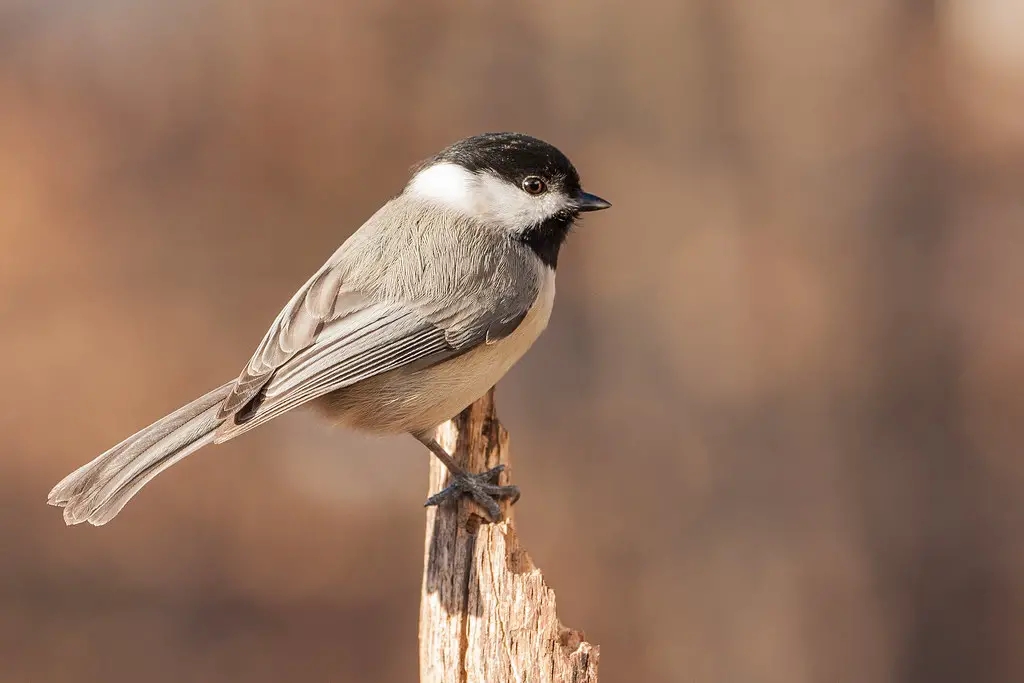
Image Source
- Scientific name: Poecile carolinensis
- Lifespan: 2-8 years
- Size: 11-13 centimeters (4-5 inches)
- Origin: North America
The Carolina Chickadee (Poecile carolinensis) is a small, lively bird native to the southeastern United States. With its striking black cap and bib, white cheeks, and grayish wings, this charming chickadee is a familiar sight in woodlands, parks, and suburban areas.
Carolina Chickadees are highly vocal, emitting their signature “chick-a-dee-dee-dee” call, which gives them their name. They are agile foragers, flitting from branch to branch, searching for insects, seeds, and berries. These birds are also known to cache food for later consumption.
During the breeding season, Carolina Chickadees excavate cavities in trees or use nest boxes. The female lays a clutch of 5 to 8 eggs, which are incubated by both parents.
These sociable birds often form mixed flocks with other species, such as titmice and nuthatches. Their delightful presence, acrobatic movements, and cheerful calls make them a favorite among birdwatchers and nature enthusiasts.
Black Phoebe

Image Source
- Scientific name: Sayornis nigricans
- Lifespan: Up to 8 years
- Size: Approximately 16-19 centimeters (6.3-7.5 inches)
- Origin: North America (found in regions such as the United States and Mexico
Black Phoebe is a small passerine bird native to western North America. It belongs to the flycatcher family and is known for its sleek black plumage and distinctive tail-wagging behavior. Here is a short description of the Black Phoebe’s behavior and habitat:
Behavior:
Black Phoebes are highly territorial birds and can often be seen perched on low branches or rocks near water bodies, such as streams, rivers, or ponds. They are primarily insectivorous and feed on a wide variety of flying insects, including flies, bees, and beetles. Black Phoebes employs a unique hunting technique by perching and sallying out to catch their prey in mid-air. They also occasionally catch insects from the ground or vegetation.
One of the most notable behaviors of the Black Phoebe is its tail-wagging motion. It constantly flicks and pumps its tail up and down, which is believed to be a form of communication or a display of territoriality. This behavior helps distinguish the Black Phoebe from other similar-looking species.
Habitat:
Black Phoebes inhabit a range of habitats in western North America, including riparian areas, open woodlands, suburban areas, and even urban environments. They have a preference for locations near water, as it provides a steady source of insects for their diet. They are often found near streams, ponds, and other water bodies, where they perch on rocks, branches, or man-made structures like bridges.
When it comes to nesting, Black Phoebes construct cup-shaped nests made of mud, plant fibers, and grasses. They typically place their nests on sheltered ledges, cliffs, or man-made structures like buildings or bridges. The female lays a clutch of 3-5 eggs, which are incubated by both parents. Once the chicks hatch, both parents participate in feeding and caring for the young.
Black Phoebes are non-migratory birds, although some individuals may move to lower elevations during the winter months in search of milder climates and better food availability.
Northern Parula (Grey and Yellow Birds )
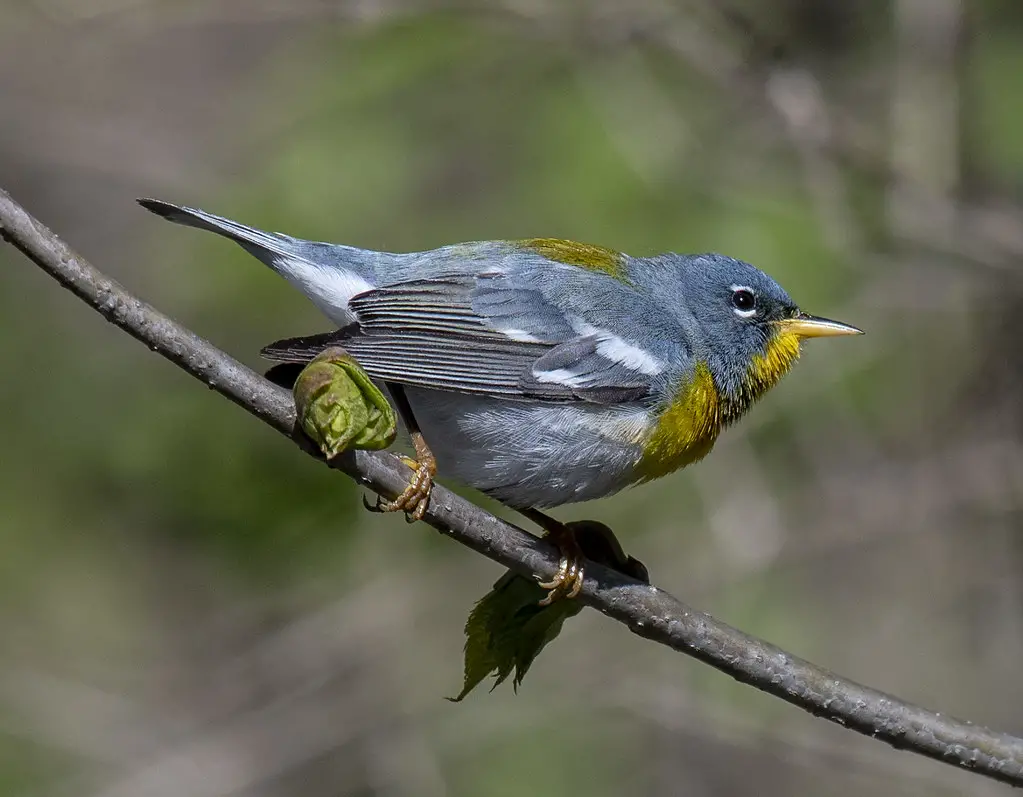
Image Source
- Scientific name: Setophaga americana
- Lifespan: Up to 7 years
- Size: Approximately 11-13 centimeters (4.3-5.1 inches)
- Origin: North America (found in regions such as Canada and the United States)
The Northern Parula (Setophaga americana) is a small migratory songbird found in North America. It is known for its vibrant blue-gray upper parts, yellow throat and breast, and distinctive eye crescents. Here is a short description of the Northern Parula’s behavior and habitat:
Behavior:
Northern Parulas are lively and energetic birds known for their high-pitched, buzzy song. Their song consists of a series of ascending notes followed by a trill, and it can be heard as they forage for insects among tree branches and foliage. They have a distinctive call, often described as a soft “tsee-tsee-tsee.”
These birds are primarily insectivorous, feeding on small insects and spiders. They often engage in hover-gleaning, where they hover briefly in mid-air to snatch insects from leaves or branches. Northern Parulas are also known to feed on nectar and occasionally consume berries and other small fruits.
Habitat:
Northern Parulas prefer mature deciduous and mixed forests with a dense canopy, particularly those near water bodies such as swamps, wetlands, and streams. They are found throughout their breeding range in eastern North America, from southern Canada to the southeastern United States.
During the breeding season, Northern Parulas construct cup-shaped nests made of bark strips, moss, and other plant materials. They often place their nests on the fork of a tree branch, usually at a medium height above the ground. The female lays a clutch of 3-7 eggs, which are incubated by both parents for about two weeks. After hatching, the chicks are cared for by both parents and fledge in around two weeks.
Northern Parulas are migratory birds, spending the winter months in the southeastern United States, Mexico, Central America, and the Caribbean. They undertake long-distance migrations to reach their breeding and wintering grounds.
Blue-gray Gnatcatcher

Image Source
- Scientific name: Polioptila caerulea
- Lifespan: 3-4 years
- Size: 3.9–5.1 in
- Native to: North America
Blue-gray Gnatcatcher is a small, insect-eating bird found in North America. With its vibrant blue-gray plumage, long tail, and white eye-ring, this agile bird is easily identifiable.
Blue-gray Gnatcatchers inhabit various wooded habitats, including forests, woodlands, and thickets. They are highly active and constantly on the move, flitting through foliage and catching insects in mid-air. These birds have a distinctive soft, high-pitched call that resembles a buzzing sound.
They construct exquisite cup-shaped nests, often using spider silk, lichens, and plant fibers, cleverly camouflaging them among the branches. The female lays a clutch of 3 to 5 eggs, which are incubated by both parents.
Blue-gray Gnatcatchers are migratory birds, spending the winter in the southern parts of their range and returning to their breeding grounds in the spring. Their insect-eating habits make them valuable in controlling pest populations.
These delightful birds bring liveliness and a splash of color to the woodlands, and their captivating behavior and songs make them a favorite among birdwatchers and nature enthusiasts.
Willow Flycatcher
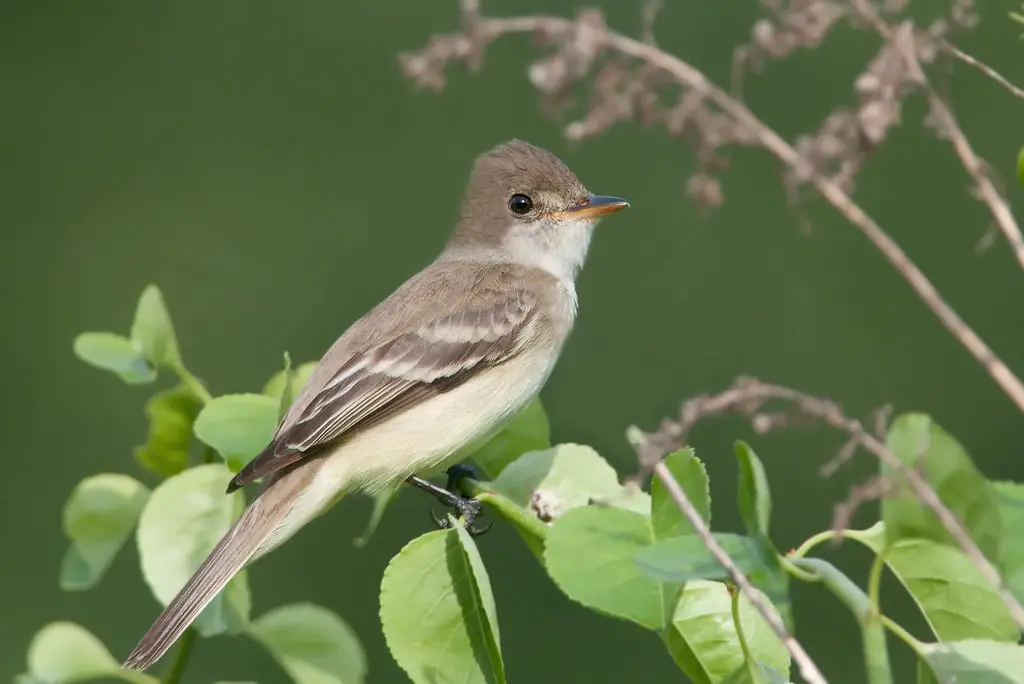
Image Source
- Scientific name: Empidonax traillii
- Lifespan: 2-6 years
- Size: 12-14 centimeters (5-6 inches)
- Origin: North America
Willow Flycatcher is a small, migratory bird that breeds across much of North America. They are known for their distinctive “fitz-bew” song, which is a series of high-pitched, descending notes.
These birds are typically found in open woodland areas, often near streams or wetlands. They feed on insects, which they catch in mid-air or glean from vegetation. The Willow Flycatcher has olive-brown upper parts and a pale grayish-white underbelly with a yellowish tint.
Willow Flycatchers are known for their relatively low reproductive rates, with females typically laying only three to four eggs per year. They build their nests in dense shrubs, often near water sources. Conservation efforts have been made to protect the habitats of Willow Flycatchers, as their populations have declined due to habitat loss and degradation.
Loggerhead Shrike
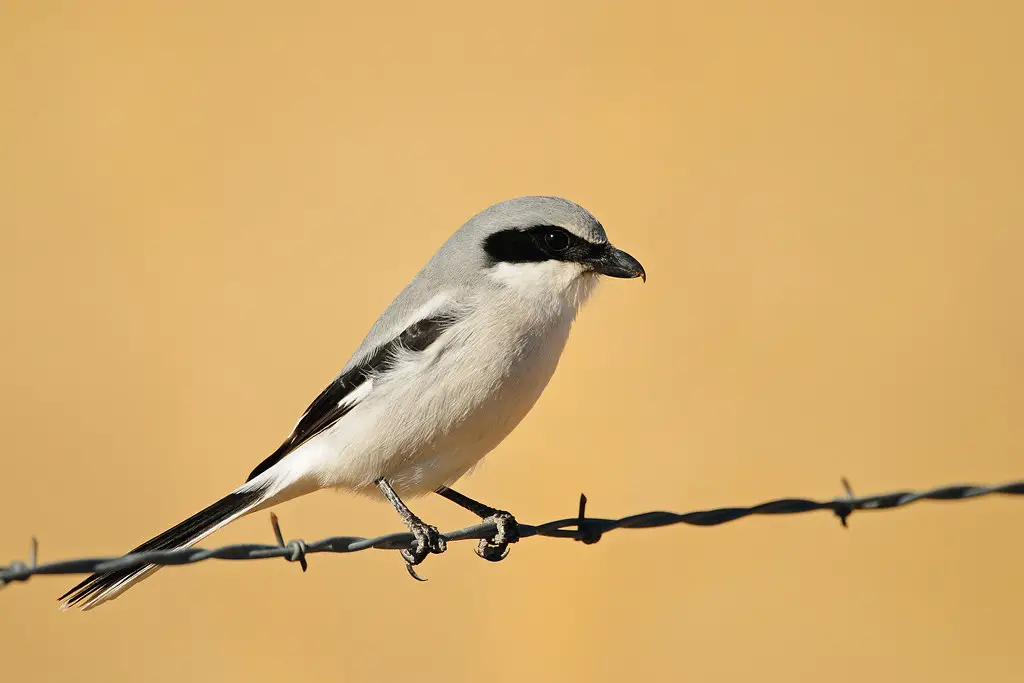
Image Source
- Scientific name: Lanius ludovicianus
- Lifespan: Up to 9 years
- Size: Approximately 20-24 centimeters (7.9-9.4 inches)
- Origin: North America (found in regions such as Canada, United States, and Mexico)
The Loggerhead Shrike is a small predatory songbird found in North America. It is known for its distinctive gray coloration, black mask across its eyes, and hooked beak. Here is a short description of the Loggerhead Shrike’s behavior and habitat:
Behavior:
Loggerhead Shrikes are predatory birds that exhibit unique hunting behaviors. Despite being relatively small, they possess a strong, hooked beak that allows them to capture and kill prey efficiently. They primarily feed on insects, small mammals, birds, reptiles, and even other songbirds. Loggerhead Shrikes are often referred to as “butcher birds” due to their habit of impaling their prey on thorns or barbed wire fences. This behavior serves as a way to store food and tear apart their prey for consumption.
In terms of vocalizations, Loggerhead Shrikes have a repertoire of songs and calls, including harsh, raspy notes. They use vocalizations to communicate with their mate and defend their territory.
Habitat:
Loggerhead Shrikes inhabit a range of habitats across North America, including open fields, grasslands, shrublands, and savannas. They prefer areas with scattered trees or shrubs, which provide perches for hunting and nesting.
During the breeding season, Loggerhead Shrikes construct nests made of twigs, grasses, and feathers, usually located in shrubs or small trees. The female lays a clutch of 4-8 eggs, which are incubated by both parents for about two weeks. Both parents also participate in feeding and caring for the chicks until they fledge and become independent.
Loggerhead Shrikes are partially migratory, with some populations migrating south for the winter months. However, other populations are year-round residents in their respective territories.
Rock Pigeon

Image Source
- Scientific name: Columba livia
- Lifespan: Up to 15 years
- Size: Approximately 30-36 centimeters (11.8-14.2 inches)
- Origin: Europe, Asia, and North Africa (introduced worldwide)
The Rock Pigeon also known as the Common Pigeon or Rock Dove, is a medium-sized bird that is widely distributed across the world. It is best recognized for its plump body, grayish plumage, and characteristic cooing calls. Here is a short description of the Rock Pigeon’s behavior and habitat:
Behavior:
Rock Pigeons are social birds known for their strong flocking behavior. They are often seen in urban areas, roosting and nesting on buildings, bridges, and other man-made structures. They have a remarkable homing instinct, which has been utilized for centuries in pigeon racing and messenger pigeon activities.
These birds have a gentle and calm demeanor, often bobbing their heads and walking with a characteristic strut. They communicate through a variety of vocalizations, including the famous “cooing” sound made by males during courtship displays. Rock Pigeons also engage in elaborate flight displays, soaring and gliding gracefully in the sky.
Habitat:
Rock Pigeons have adapted well to a variety of habitats, including urban areas, coastal cliffs, and rocky outcrops. They are native to western and southern Europe, North Africa, and parts of Asia, but have been introduced and naturalized in many regions worldwide.
In urban environments, Rock Pigeons often rely on buildings and structures for roosting and nesting. They build simple nests made of twigs, grass, and debris in sheltered ledges or cavities. They can breed throughout the year, with females typically laying two eggs per clutch. Both parents share incubation duties, and the chicks fledge in about three to four weeks.
Rock Pigeons are omnivorous and feed on a varied diet. They primarily consume seeds, grains, and fruits, but will also scavenge for food scraps in urban areas.
Due to their adaptability and widespread distribution, Rock Pigeons are often considered a pest species in certain environments. However, they are also appreciated and admired by many people for their peaceful presence and historical connections.
Warbling Vireo
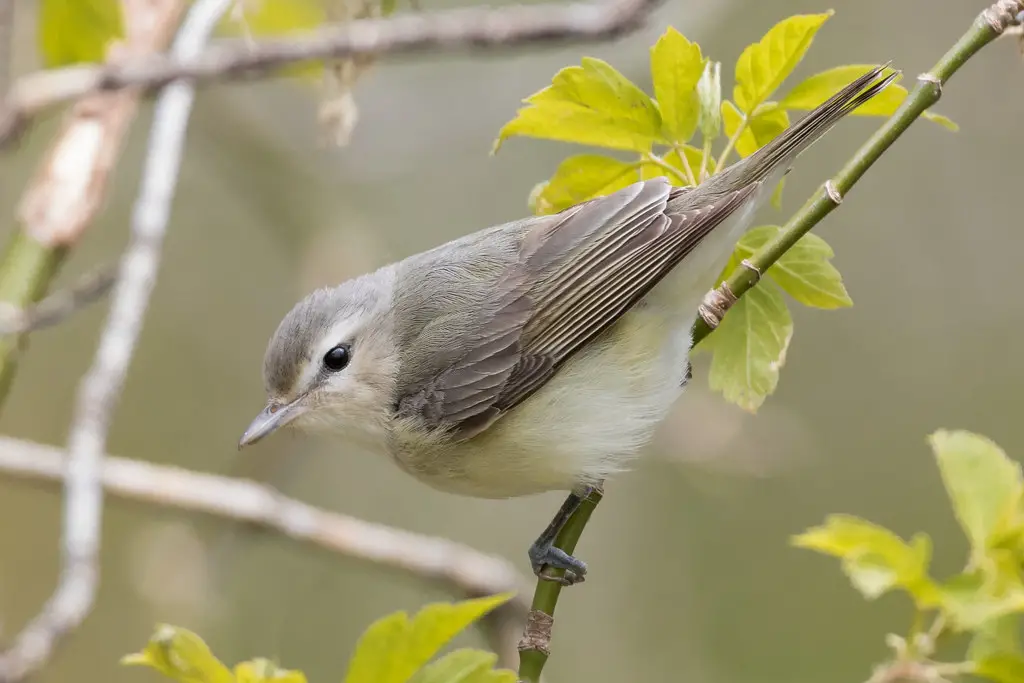
Image Source
- Scientific name: Vireo gilvus
- Lifespan: Up to 10 years
- Size: Approximately 12-14 centimeters (4.7-5.5 inches)
- Origin: North America (found in regions such as Canada and United States)
The Warbling Vireo is a small migratory songbird found in North America. It is known for its olive-green plumage, white underparts, and distinctive warbling song. Here is a short description of the Warbling Vireo’s behavior and habitat:
Behavior:
Warbling Vireos are primarily insectivorous birds and spend much of their time foraging for insects among tree canopies. They have a slender bill, which they use to pick insects from leaves and branches. Their diet also includes spiders and other small invertebrates. These birds are known for their constant warbling songs, which consist of a series of rich, melodious notes. Their songs are often described as cheerful and musical, and they can be heard throughout their breeding territories.
Warbling Vireos are known for their relatively calm and inconspicuous nature. They are not as flashy as some other bird species, and they often blend in with the foliage due to their green plumage. They can be seen hopping and flitting among tree branches while searching for food.
Habitat:
Warbling Vireos breed in a variety of wooded habitats, including deciduous and mixed forests, river corridors, and wooded parks. They prefer areas with mature trees and a dense canopy, providing ample foliage for foraging and nesting.
During the breeding season, Warbling Vireos construct cup-shaped nests made of plant fibers, grasses, and spider silk. The nests are usually placed in the fork of a tree branch, well hidden among the leaves. The female lays a clutch of 3-5 eggs, which are incubated by both parents for about two weeks. After hatching, both parents participate in feeding and caring for the chicks until they fledge.
Warbling Vireos undertake long-distance migrations, spending the winter months in Central and South America. They have a distinctive flight pattern, often seen making short, fluttering flights interspersed with brief glides.
Bushtit
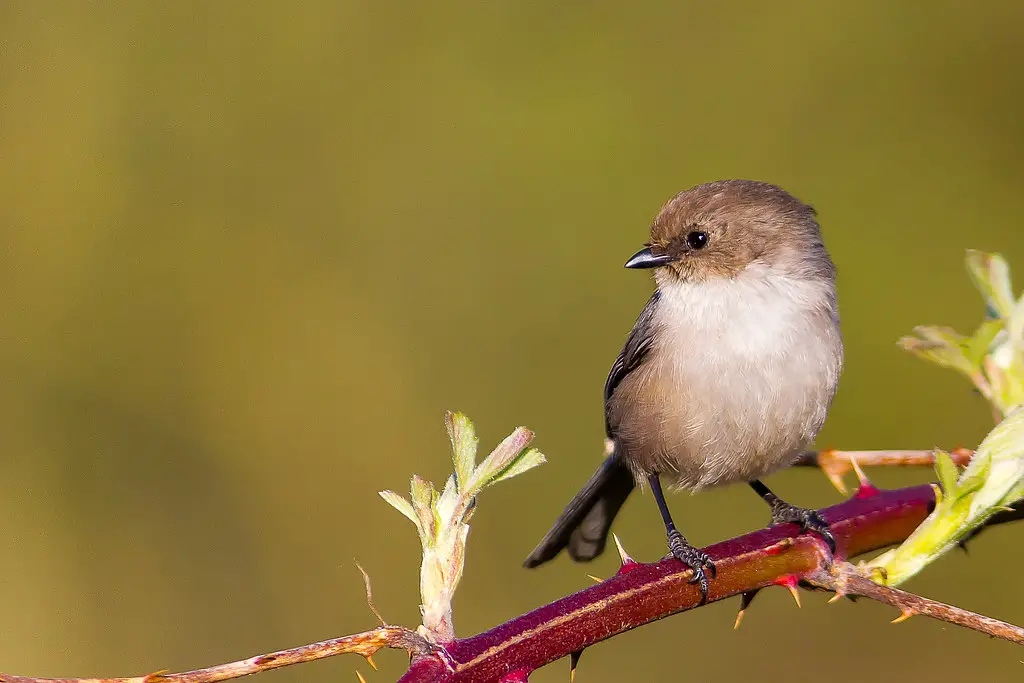
Image Source
- Scientific name: Psaltriparus minimus
- Lifespan: 2-7 years
- Size: 10-11 centimeters (4-4.3 inches)
- Origin: North America
The Bushtit (Psaltriparus minimus) is a small, sociable bird native to North America. These tiny birds are known for their fluffy appearance and their habit of traveling in large, chattering flocks.
Bushtits have grayish-brown plumage, long tails, and a stubby bill. They are highly acrobatic and are often seen hanging upside down from branches, searching for insects and spiders. They also feed on berries and small seeds.
These birds build intricate, pendant-shaped nests made of moss, spider webs, and plant fibers. The nests are often concealed in dense foliage, providing protection for their eggs and young.
Bushtits are cooperative breeders, with multiple individuals assisting in nest building and raising the young. Their social nature and synchronized movements within the flock are a remarkable sight to behold.
Band-tailed Dove

Band-tailed Doves are about 13 inches long with a wingspan of approximately 23 inches. They have plump, round bodies, small heads, and long, pointed tails. Their plumage is generally grayish-brown with a lighter-colored head and neck.
Band-tailed Doves are primarily seed eaters, but they also consume fruits, insects, and snails. They are known to be opportunistic feeders and will eat a variety of food depending on what is available.
During the breeding season, these birds form pairs and build their nests in trees or shrubs. Females usually lay one or two eggs, and both parents take turns incubating them for about two weeks. The chicks fledge after about two weeks and become fully independent about a week later.
Band-tailed Doves are an important game bird, and their populations are closely monitored by wildlife management agencies. They are also appreciated by birdwatchers for their unique appearance and behavior. In some areas, they are considered a pest because they can cause damage to crops and gardens. Overall, Band-tailed Doves are an important part of the ecosystem and play a role in seed dispersal and pollination.
Eastern Kingbird
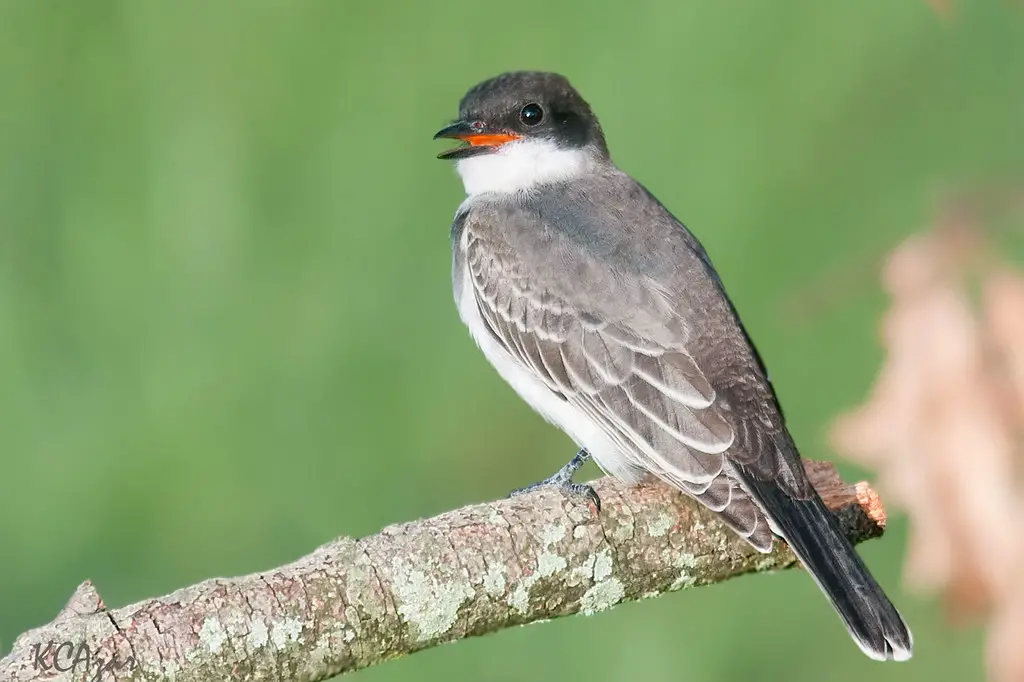
Image Source
- Scientific name: Tyrannus tyrannus
- Lifespan: Up to 10 years
- Size: Approximately 19-23 centimeters (7.5-9.1 inches)
- Origin: North America (found in regions such as Canada and the United States)
The Eastern Kingbird (Tyrannus tyrannus) is a medium-sized migratory bird found in North America. It is known for its sleek black plumage, white underparts, and a distinctive white-tipped tail. Here is a short description of the Eastern Kingbird’s behavior and habitat:
Behavior:
Eastern Kingbirds are highly territorial and assertive birds. They are known for their aggressive behavior when it comes to defending their nesting territory and young. Despite their small size, they fearlessly chase and mob much larger birds, such as hawks and crows, to protect their nest and offspring. They are also skilled aerial hunters, catching insects in mid-air during acrobatic flights.
These birds communicate through a variety of calls, including a loud, sharp “kip” or “tsip” sound. They are not known for complex songs but may produce soft, warbling sounds during courtship displays.
Habitat:
Eastern Kingbirds can be found in a variety of open habitats, including fields, meadows, woodland edges, and riparian areas. They are often observed perched on wires, tree branches, or other prominent structures from where they can scan their surroundings for insects.
These birds construct cup-shaped nests made of twigs, grass, and plant fibers. The nests are usually located in shrubs, small trees, or even on man-made structures. Eastern Kingbirds lay a clutch of 2-4 eggs, which are incubated by both parents for about two weeks. After hatching, both parents actively care for the chicks and provide them with a diet of insects.
Eastern Kingbirds are migratory, spending the winter months in South America. They undertake long-distance migrations, often flying in flocks, and return to their breeding grounds in North America during the warmer months.
Black-and-white Warbler

- Scientific name: Mniotilta varia
- Lifespan: about 11 years
- Wingspan: 7.1-8.7 in
- Native to: As far north as northern Canada and winter as far south as northern South America
The Black-and-white Warbler has two white wing stripes on its black wings, as well as black upperparts with white stripes.
The white stripes seem more like white streaks or specks when the wings are folded.
Female Black-and-White Warblers resemble males almost identically, unlike many other warbler species, with the exception that they lack the black patch that would have increased the white area on their heads.
The Black and White Warbler is found in eastern North America, from Canada in the north to Texas in the south. Its breeding season runs from May to August.
A minor portion of this bird’s population winters in Florida and the Gulf Coast as a seasonal migrant who spends the winter in Central America.
It inhabits a variety of woodland settings and eats tiny insects and other invertebrates.
Are Black and White Warblers friendly? They are not considered friendly birds and are quite fierce in nature. they will attack other birds that try to enter their territory.
Dark-eyed Junco
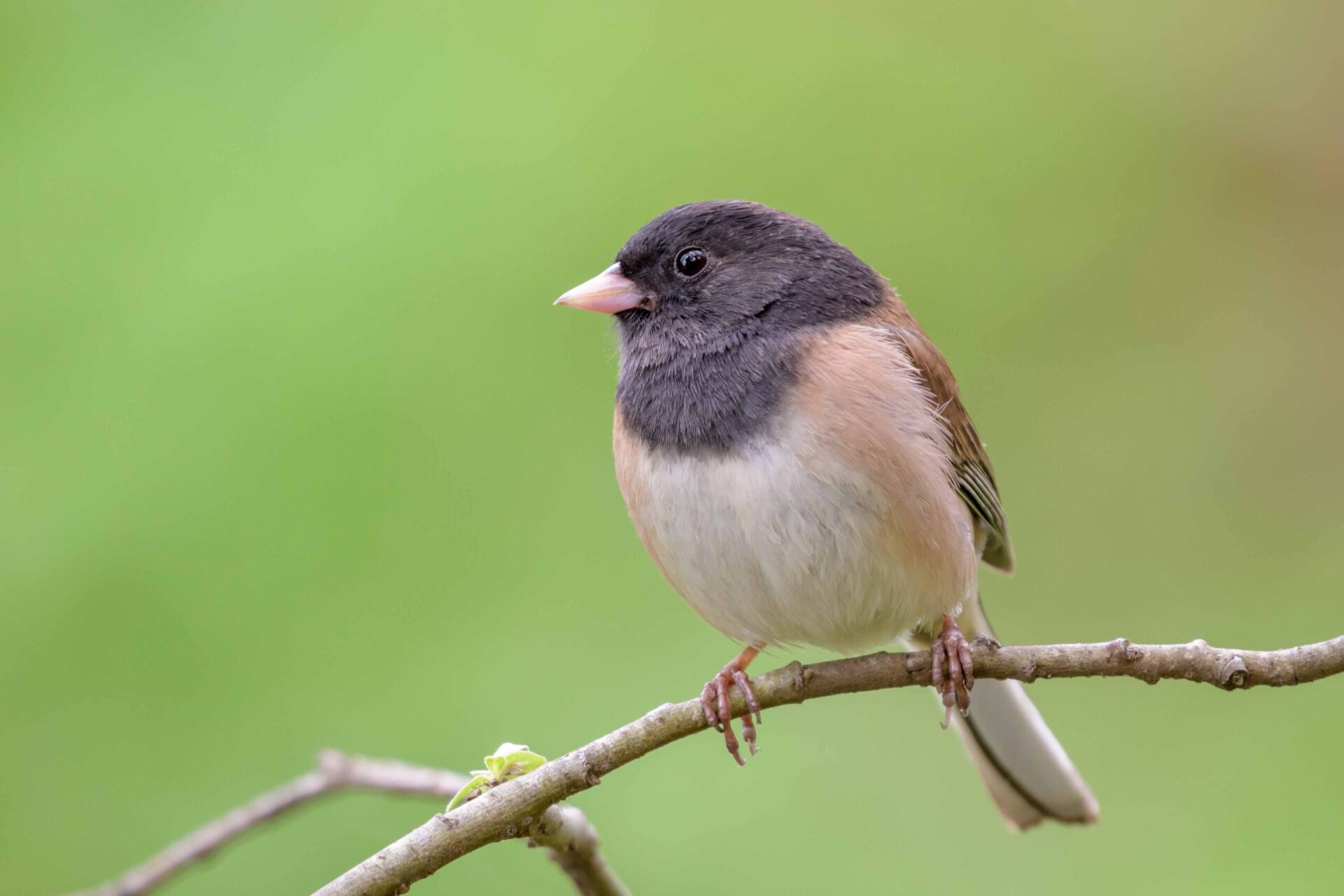
Image Source
- Scientific name: Junco hyemalis
- Lifespan: 3-11 years
- Size: 14-16 centimeters (5.5-6.3 inches)
- Origin: North America
The Dark-eyed Junco (Junco hyemalis) is a small, migratory bird that is widely distributed across North America. These charming sparrows are known for their distinctive plumage variations, with several subspecies displaying different color patterns.
The most common form, the “Slate-colored Junco,” has a dark gray to blackish upper body, white underparts, and a crisp white belly. Other variations include the “Oregon Junco,” “Pink-sided Junco,” and “Gray-headed Junco,” each with its own unique coloration.
Dark-eyed Juncos inhabit a variety of habitats, including forests, woodlands, and suburban areas. They primarily feed on seeds and insects, foraging on the ground with their characteristic hopping movements.
During the breeding season, Dark-eyed Juncos build cup-shaped nests on or near the ground, typically concealed among dense vegetation. Females lay a clutch of 3 to 5 eggs, which they incubate for about two weeks.
These adaptable birds migrate to different regions depending on the subspecies, with some residing year-round in certain areas. Their delightful presence and distinct color variations make them a favorite among birdwatchers, bringing joy to many nature enthusiasts.
Eastern Wood-pewee
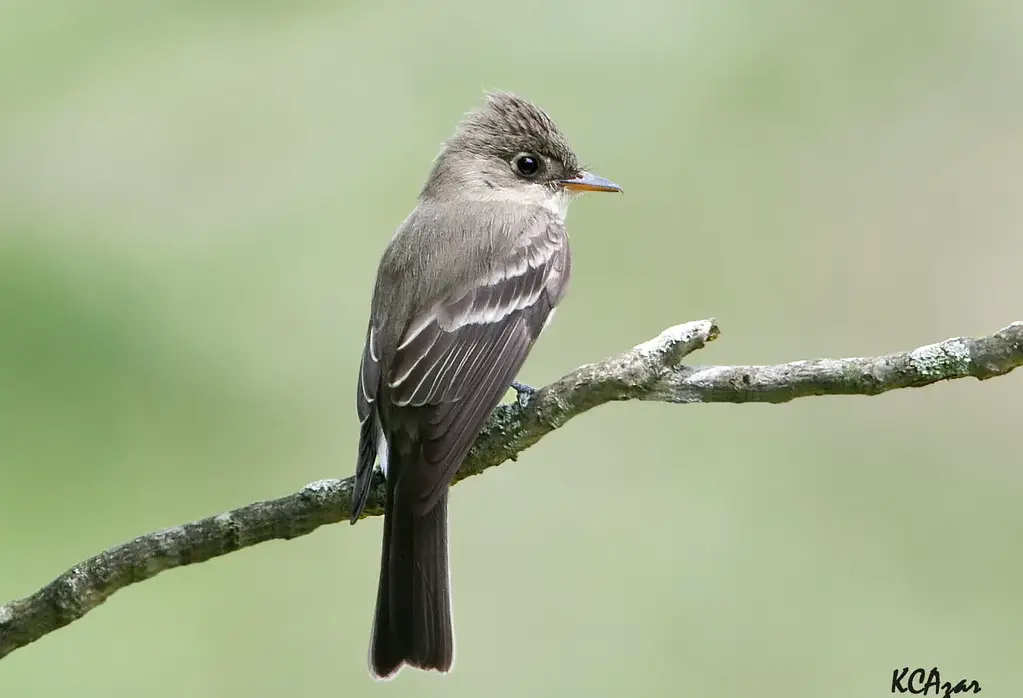
Image Source
- Scientific name: Contopus virens
- Lifespan: Up to 7 years
- Size: Approximately 14-16 centimeters (5.5-6.3 inches)
- Origin: North America (found in regions such as Canada and United States)
The Eastern Wood-Pewee (Contopus virens) is a small migratory songbird found in North America. It is known for its olive-brown plumage, pale underparts, and distinctive call. Here is a short description of the Eastern Wood-Pewee’s behavior and habitat:
Behavior:
Eastern Wood-Pewees are flycatchers that specialize in capturing insects on the wing. They spend much of their time perched on high branches, patiently watching for flying insects. Once an insect is spotted, they swiftly launch into the air, catching their prey in mid-flight before returning to their perch. They have a distinct call that sounds like a melancholic “pee-a-wee,” which is often repeated throughout the day.
These birds are relatively solitary and often establish territories in forested areas. They are not particularly territorial with other Eastern Wood-Pewees but may exhibit aggressive behavior towards other bird species that encroach on their territory.
Habitat:
Eastern Wood-Pewees inhabit a variety of wooded habitats, including deciduous and mixed forests, woodlands, and forest edges. They prefer areas with tall trees and a dense canopy that provides perches for hunting and nesting.
During the breeding season, Eastern Wood-Pewees construct cup-shaped nests made of twigs, grasses, and plant fibers. The nests are usually placed on horizontal tree branches, well hidden among the foliage. The female lays a clutch of 2-4 eggs, which are incubated by both parents for about two weeks. After hatching, both parents participate in feeding and caring for the chicks until they fledge.
Eastern Wood-Pewees are migratory birds, spending the winter months in Central and South America. They undertake long-distance migrations, often flying at night, to reach their breeding and wintering grounds.
Say’s Phoebe

Image Source
- Scientific name: Sayornis saya
- Lifespan: Up to 9 years
- Size: Approximately 15-18 centimeters (5.9-7.1 inches)
- Origin: North America (found in regions such as United States and Mexico)
The Say’s Phoebe (Sayornis saya) is a small passerine bird native to western North America. It is known for its muted gray-brown plumage, pale underparts, and long tail. Here is a short description of Say’s Phoebe’s behavior and habitat:
Behavior:
Say’s Phoebes are primarily insectivorous birds, and they are often seen perched on low branches, fence posts, or other elevated perches, from where they sally out to catch flying insects. They have a distinctive habit of wagging their tails up and down, which helps in their identification. Say’s Phoebes are also known for their soft, wheezy calls, often described as a repeated “phee-bee” or “phee-o.”
These birds are solitary and territorial, defending their preferred foraging areas from other individuals. They are generally calm and patient, displaying a quiet and unassuming nature.
Habitat:
Say’s Phoebes inhabit a variety of open habitats in western North America, including deserts, grasslands, shrublands, and agricultural areas. They have a preference for semi-arid regions and often nest in cliff faces or man-made structures such as buildings, bridges, and barns.
During the breeding season, Say’s Phoebes construct cup-shaped nests made of grass, twigs, and plant fibers. The nests are usually placed in a sheltered location, such as a ledge or cavity, and are lined with softer materials like feathers or fur. The female lays a clutch of 4-6 eggs, which are incubated by both parents for about two weeks. Once the chicks hatch, both parents participate in feeding and caring for the young.
Say’s Phoebes are partially migratory, with some individuals migrating to lower elevations or southward during the winter months, while others remain in their breeding territories year-round.
Eastern Phoebe (Black and Grey Bird )
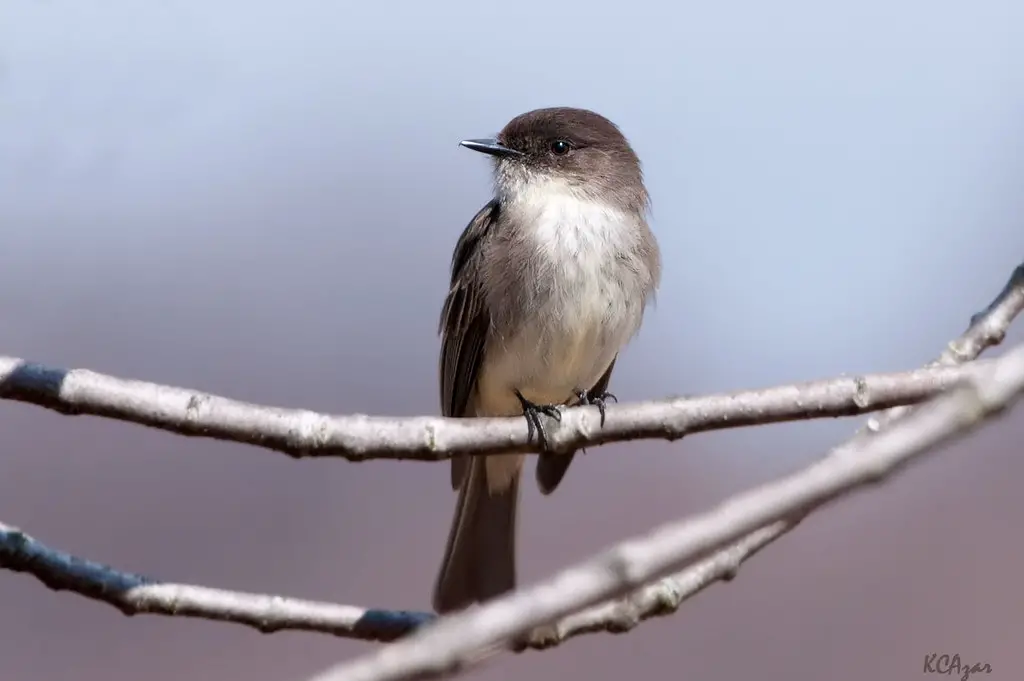
Image Source
- Scientific name: Sayornis phoebe
- Lifespan: 10 years
- Size: 5.5-6.7 in
- Native to: North America
The Eastern Phoebe (Sayornis phoebe) is a small, insect-eating bird native to eastern North America. This charming bird is known for its characteristic tail-wagging behavior and distinctive call, which sounds like “fee-bee” or “phoebe.”
Eastern Phoebes have a brownish-gray upper body and a pale yellowish underbelly. They often perch on branches or fences, waiting patiently to spot their prey. When they spot an insect, they swoop down to catch it in mid-air before returning to their perch.
These birds typically build their nests on ledges, cliffs, or man-made structures such as bridges and buildings. They use mud, moss, and plant fibers to construct cup-shaped nests, which they line with softer materials like feathers.
Eastern Phoebes are migratory birds, spending their winters in the southern United States and Mexico, and returning to their breeding grounds in the eastern regions during the spring. Their adaptable nature, insect-eating habits, and delightful songs make them a favorite among birdwatchers and nature enthusiasts.
Sagebrush Sparrow

Image Source
- Scientific name: Artemisiospiza nevadensis
- Lifespan: 2-3 years
- Size: 13-15 centimeters (5-6 inches)
- Origin: North America
The Sagebrush Sparrow (Artemisiospiza nevadensis) is a small songbird found in the sagebrush plains of western North America. They are often found in dry, arid habitats such as sagebrush, grasslands, and deserts.
Sagebrush Sparrows have distinctive streaky brown and gray plumage with a pale eyebrow and a dark eye patch. They have a sweet, melodic song and a soft, buzzy call.
These birds are ground-nesters and build their nests in grassy areas, using grass and other vegetation to construct a cup-shaped structure. The female typically lays a clutch of 3 to 5 eggs.
Sagebrush Sparrows are considered a species of concern due to habitat loss caused by human activities such as agriculture and energy development. Conservation efforts are underway to protect their dwindling populations and their unique habitat.
Final Thoughts on Grمy Birds
As we conclude our exploration of grey birds, we have delved into a world of understated beauty and subtle charm. These birds, with their muted plumage, have revealed their unique characteristics, habitats, and behaviors. From the depths of forests to the shores of waterways, grey birds have showcased their adaptability and grace in various environments. Through this journey, we have gained a deeper appreciation for the diversity and allure that grey birds bring to our natural world. Let us continue to cherish and protect these remarkable avian wonders, for they remind us that beauty can be found in the most understated of forms.
Further Readings
- Gray Birds with Yellow Bellies
- Black Birds with Gray Heads
- Gray Birds with Red Heads
- Gray Birds with White Bellies
List of Gray Birds in North America
- Dark-eyed Junco
- Gray Catbird
- European Crested Tit
- Black-capped Chickadee
- Northern Mockingbird
- White-breasted Nuthatch
- Tufted Titmouse
- Carolina Chickadee
- Black Phoebe
- Northern Parula
- Blue-Gray Gnatcatcher
- Willow Flycatcher
- Loggerhead Shrike
- Rock Pigeon
- Warbling Vireo
- Bushtit
- Band-tailed Dove
- Eastern Kingbird
- White-winged Dove
- Black-and-white Warbler
- Eastern Wood-pewee
- Say’s Phoebe
- Sagebrush Sparrow


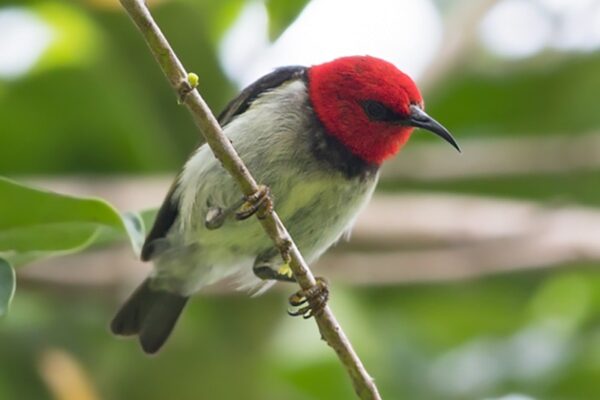
![Gray Birds with White Bellies [Beauty in Subtle Contrasts]](https://birdsology.com/wp-content/uploads/2023/05/european-crested-tit-7677811_128-600x400.jpg)
9 thoughts on “23 Beautiful Grey Birds in North America [Images + IDs]”